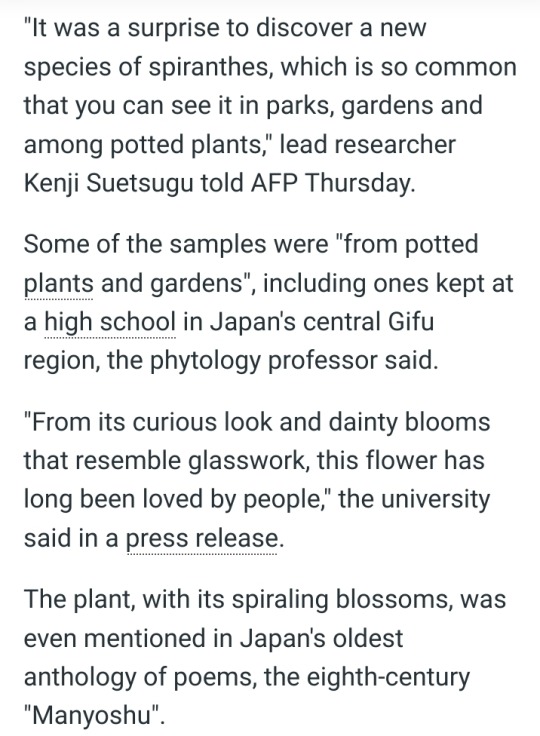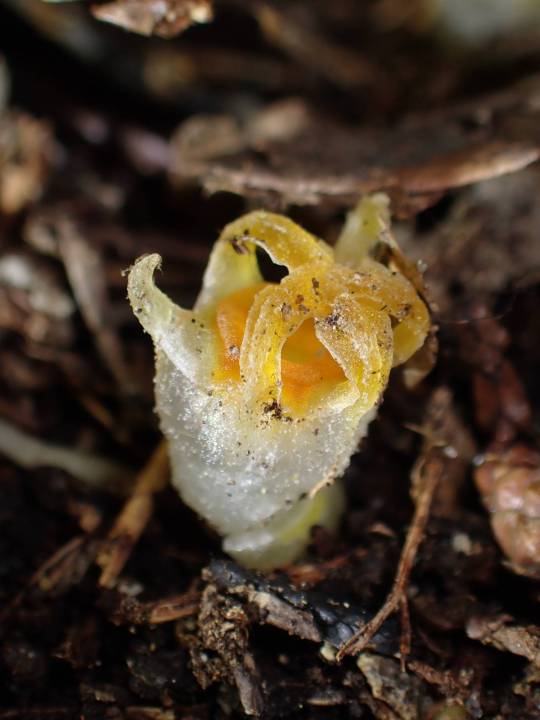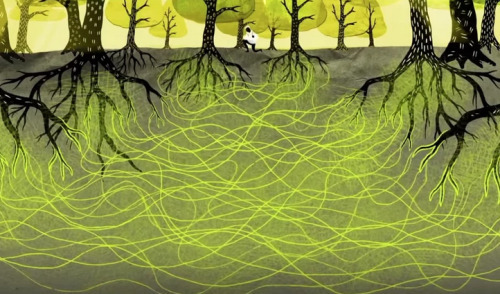#Kenji Suetsugu
Explore tagged Tumblr posts
Text




#Spiranthes hachijoensis#‘glass-like’ orchid#orchids#Kenji Suetsugu#Kobe University#Japan#Manyoshu#ladies’ tresses#Journal of Plant Research
8 notes
·
View notes
Text
Eternal Flower Files Short: Thismia


Sources: (1) CNET - Freaky Fairy Lantern (2) Kenji Suetsugu via Japan Times
In Eternal Flower Files II: Flowers of the Fleur de Lys, I talked about the flowers that most likely inspired Eternal Flower Floette. But there's one flower that didn't really fit that theory, even though it's really interesting.
Instead, it fit my crazy fungus theory better. This is thismia, the elusive flower that feeds on fungi. They are also known as Fairy Lanterns, which is so appropriate for Kalos. Fairy Lanterns are an incredibly rare, elusive flower. Thismia kobensis (the one on the right) was recently rediscovered in Japan after decades of being thought to be extinct. Same with thismia neptunis. There are so many stories of researchers searching for thismia species across the world, and the rarity and adventure to just find one reminds me of the Eternal Flower.
Back in my earlier post "Xerneas and Yveltal are Fungus - Let Me Explain..." I theorized that Xerneas and Yveltal are a kind of fungi, because of their bio-luminescent appearance and their life supporting and life draining properties. I also lichened Yggdrasil to the mychorrhizal network, a network of mycelium that unite other fungi and plants into a beneficial symbiotic relationship. Truly a harmonious collective.

Source: BBC News - How Trees Secretly Talk to Each Other
Well, the Fairy Lantern is one flower that exploits that symbiotic relationship! Talk about a bad relationship. Fairy Lanterns are parasitic, ironically plants that leech the life from fungi. Many of them also have six petals, just like the flowers depicted in the Fleur de lys. Of course, the Fairy Lantern probably isn't an inspiration for the Eternal Flower, but its parasitic relationship with fungi reminds me of the way AZ's Ultimate Weapon leeches off of Xerneas and Yveltal to do its thing. I just wanted to write about it!
I learned about thismia from Animalogic.
#Eternal Flower Files#Eternal Flower Floette#Thismia#Fairy Lanterns#Pokemon Legends: Z-A#Pokemon Legends Z-A#Pokemon Legends Zygarde#Pokemon Legends ZA#Pokemon Legends Z#Pokemon Z-A#Z-A#Zygarde#Pokemon#Pokemon games#gaming#Kalos#Pokemon XY#Pokemon Z#Pokemon XYZ#Gen 6#Generation 6#Floette#Gen VI#Gen VI Pokemon#Video games#AZ#Z-A theories#Nintendo#Pokemon theories
7 notes
·
View notes
Text
ESTINTA 30 ANNI FA, RITROVATA LA PIANTA CHE FA LUCE

La Thismia è una delle piante più strane del mondo vegetale. Cresce sottoterra facendo luce attraverso il terreno e per questo motivo è comunemente conosciuta come ‘lanterna delle fate’. A differenza della maggior parte dei vegetali della sua specie non ha foglie né svolge la fotosintesi. I membri di questa famiglia di piante sono monocotiledoni micoeterotrofe che dipendono dai funghi per la loro nutrizione e dagli alberi vicino ai quali crescono.
L’ultimo esemplare di Thismia kobensis fu avvistato a Kobe City, in Giappone, nel 1992. Il suo habitat distrutto dalla costruzione di un complesso industriale non ha più permesso di individuarne altri esemplari e la pianta si presumeva estinta. Dopo più di 30 anni, il professor Kenji Suetsugu e i suoi colleghi dell’Università di Kobe hanno annunciato la sua riscoperta a Sanda City, a poco meno di 20 chilometri dal luogo in cui venne vista l’ultima Thismia. “Trovare un membro di un genere così raro e in via di estinzione è incredibilmente eccitante e le successive indagini hanno gettato nuova luce sul genere e sulla sua storia evolutiva”. “Sebbene le piante delle specie di Thismia siano minuscole e poco appariscenti, sono state descritte come uno dei generi più curiosi e straordinari del regno vegetale e il loro strano aspetto e la loro strategia di vita le rendono eccezionali tra le erbe”, scrivono gli autori dell’Università di Kobe nello studio dove hanno reso noto i risultati della loro scoperta.
___________________
Fonte: Biotaxa

VERIFICATO ALLA FONTE | Guarda il protocollo di Fact checking delle notizie di Mezzopieno
BUONE NOTIZIE CAMBIANO IL MONDO | Firma la petizione per avere più informazione positiva in giornali e telegiornali

Se trovi utile il nostro lavoro e credi nel principio del giornalismo costruttivo non-profit | sostieni Mezzopieno
12 notes
·
View notes
Text
Masked Palm Civets Unmasked as Seed Dispersers for Unusual Orchid
Masked Palm Civets Unmasked as Seed Dispersers for Unusual Orchid https://ift.tt/GNljDWL The mycoheterotrophic orchid Cyrtosia septentrionalis, known for its vibrant red, sausage-shaped fruits, has found an unexpected ally in seed dispersal. While birds were thought to be its primary dispersers, recent research by Kenji Suetsugu reveals a surprising player: the carnivorous masked palm civet. This finding challenges previous assumptions about orchid seed dispersal and highlights the potential for diverse dispersal strategies in plants. The study revealed masked palm civets as primary consumers of Cyrtosia septentrionalis fruits. Unlike birds, civets crushed the fruits, consuming larger portions. Seeds remained viable after passing through the civet’s digestive system, with viability rates comparable to seeds from intact fruits. This suggests civets play a significant role in seed dispersal, potentially over longer distances due to their larger home ranges. The findings indicate C. septentrionalis likely employs a mixed bird-mammal dispersal strategy. Suetsugu conducted the study from December 2014 to February 2015 in a forest in Shiga Prefecture, Japan. He used motion-sensing cameras placed near Cyrtosia septentrionalis plants to identify fruit consumers. Civet droppings were collected and examined for orchid seeds. Seed viability was tested using 2,3,5-triphenyl tetrazolium chloride (TTC) staining. The viability of seeds from civet droppings was compared to seeds taken directly from intact fruits using statistical analysis. This study challenges previous assumptions about orchid seed dispersal. While birds were thought to be the main dispersers for Cyrtosia septentrionalis, civets may play an equally important role. Civets’ larger home ranges suggest potential for longer-distance seed dispersal compared to birds. This research adds to growing evidence of diverse seed dispersal strategies in orchids, highlighting the complex interactions between plants and animals in forest ecosystems. Suetsugu, K. (2024). Further evidence for endozoochory in a mycoheterotrophic orchid Cyrtosia septentrionalis: seed dispersal by the masked palm civet Paguma larvata. Plant Biology. https://doi.org/10.1111/plb.13718 ResearchGate: https://botany.fyi/z9w80c Cross-posted to Bluesky, Mastodon & Threads. The post Masked Palm Civets Unmasked as Seed Dispersers for Unusual Orchid appeared first on Botany One. via Botany One https://botany.one/ September 23, 2024 at 04:30AM
0 notes
Text
Thank you so much for thinking of me! This is weird because I instantly looked at this and went, “of course they weren’t grown in moulds - this is an art piece by that guy. YOU KNOW. That guy!!!” With such a specific feeling of confidence that I assumed we’d seen it before, right?
And while I went looking for it, I found That Guy (artist Kenji Suetsugu) on his Instagram (_tsukurimono_) and plenty of new references to this post going around: people reposting it on Reddit and claiming it to be the result of growing the daikon in a silicone mold, and other people saying no it isn’t, but they’re all pretty recent. Apparently “daikon legs” is a slightly insulting description of female legs in Japan, so it’s not just horrible things with legs, but also pun art, so it’s definitely in the wheelhouse of stuff I look at.


But all the conversations seemed to be pretty recent, and my brain insisted it was old news. So then I thought it was surely, surely something I had been talking about with a friend, but I cannot find any reference to daikon feet in our conversations. I definitely didn’t know the artist’s name, but my brain was pretty insistent that everyone knew about That Guy.
So I don’t know why I recognise this so instantly, and know so confidently that this was a piece by Some Guy, but there you have it.
Perhaps when I am extremely old, young people will have a good time holding up a selection of pictures to me, and I will speak prophecy on them: “that’s a meme from 2015,” I’ll say indignantly, for mild entertainment, like bilbo baggins probably did in his old age, or “They didn’t GROW those daikon, they’re an art piece. You know, by That Guy.” Net zero information, one hundred per cent confidence, no obvious utility. Is that a job? I’ll have that job.

Turnips grown in moulds.
7K notes
·
View notes
Text
Un moucheron a trouvé une solution créative pour échapper à cette plante carnivore
See on Scoop.it - EntomoNews
Des scientifiques ont découvert une relation entre une plante et un insecte à la limite du mutualisme et du parasitisme, en découvrant un moucheron qui a réussi à transformer un piège mortel en une pouponnière pour ses petits. Cette heureuse échappée commence avec une sarracénie pourpre nommée Arisaema thunbergia. Cette sarracénie produit une "odeur subtile de moisi détectable par l'humain", qui attire les moucherons à la recherche de champignons pour se nourrir et pondre leurs œufs.
Guru Med | 26 Fév 2024
L’étude publiée dans la revue Plants, People and Planet : Back from the dead: A fungus gnat pollinator turns Arisaema lethal trap into nursery.
[Image] Interaction proposée entre l’inflorescence femelle d’Arisaema thunbergii et son champignon pollinisateur, le moucheron. Leia ishitanii utilise les inflorescences mâles et femelles d’Arisaema thunbergii comme nurserie, certains individus pouvant même s’échapper des inflorescences femelles après avoir pondu. En revanche, d’autres espèces de moucherons ne pondent probablement pas d’œufs dans les inflorescences, et meurent finalement sans s’échapper des femelles et sans que leur progéniture ne réussisse à émerger. Les flèches rouges représentent les entrées et sorties des insectes, tandis que les flèches noires indiquent la séquence chronologique des événements. Conçu par Hiroki Nishigaki et Kenji Suetsugu/ Plants, People and Planet)
0 notes
Text
Japonya’da Yeni Orkide Türü Bulundu
Japonya’da Yeni Orkide Türü Bulundu Çiçeklerin kraliçesi olarak adlandırılan orkidelerin dünya genelinde 25 bin türü bulunuyor. Araştırmacılar şimdi de Japonya’da yeni bir orkide türü buldular. Kobe Üniversitesi’nden Kenji Suetsugu ve çalışma arkadaşlarının Hachijojima adasında buldukları orkideye, Spiranthes hachijoensis ismini verdiler. Bu yeni tür park ve balkon gibi şuradan yerlerde de…

View On WordPress
#hachijoensis#hechijoensis#Japonya’da Yeni Orkide Türü#Japonya’da Yeni Orkide Türü Bulundu#Spiranthes#Spiranthes hachijoensis#Spiranthes hechijoensis#Yeni Orkide Türü Bulundu
0 notes
Text
An elegant new orchid hiding in plain sight
It is extremely rare for a new plant species to be discovered in Japan, a nation where flora has been extensively studied and documented. Nevertheless, Professor SUETSUGU Kenji and his associates recently uncovered a stunning new species of orchid whose rosy pink petals bear a striking resemblance to glasswork (Fig. 1). Since it was initially spotted near Hachijo Island in Tokyo Prefecture, the new species has been given the name Spiranthes hachijoensis. Interestingly, it can be found in familiar environments such as lawns and parks, and even in private gardens and on balconies. This research suggests that other new species may be hiding in common places, eliminating the need to venture into remote tropical rainforests to discover them. The genus Spiranthes encompasses a captivating and gorgeous variety of orchids, which exhibit an array of distinctive morphological traits. The flowers are typically small and white or pinkish, and arranged in a spiral around a central stalk, hence the moniker “ladies’ tresses.” Spiranthes is the most familiar orchid in Japan and has been cherished for centuries, even appearing in the Manyoshu, Japan’s oldest extant anthology of poetry. For a long time, it was believed that the Spiranthes on the Japanese mainland constituted a single species: Spiranthes australis. However, while conducting extensive field surveys focused on Japanese Spiranthes specimens, Suetsugu came across several populations of an unknown Spiranthes taxon with hairless flower stems, on the mainland of Japan (Fig. 1). The unknown taxon often grows alongside S. australis but blooms about a month earlier, thus leading to reproductive isolation between the two taxa. Given that S. australis is characterized by a hairy flower stem, the hairless individuals may represent an overlooked species. Consequently, Suetsugu and his colleagues embarked on a comprehensive and multifaceted ten-year study to determine precisely how these plants differed. Specimens were collected from various locations in Japan, Taiwan, and Laos. By integrating results from DNA analysis, morphology, field observations, and reproductive biology, Suetsugu and his associates discovered that it is a cryptic species that exhibits a high level of molecular divergence, albeit with minimal morphological differentiation (Fig. 2). The fact that the “common” Spiranthes is actually divided into two species is likely to pique the curiosity of the general public. The discovery of a new flowering plant species in Japan is considered an extraordinarily rare event since the flora of this region has been extensively researched. However, the new species reported here can even be found growing in commonplace environments such as parks and lawns. Some specimens used to describe this new species were collected from private gardens and balconies. This discovery of new species concealed in common locales underscores the necessity of persistent exploration, even in seemingly unremarkable settings! This research was conducted by a multi-institutional team of researchers, including Professor Suetsugu (Graduate School of Science, Kobe University), Professor SUYAMA Yoshihisa (Graduate School of Agricultural Science, Tohoku University), and Dr. Tian-Chuan Hsu (Taiwan Forestry Research Institute). The paper was published online in the Journal of Plant Research on March 17, 2023. Journal InformationTitle: “Spiranthes hachijoensis (Orchidaceae), a new species within the S. sinensis species complex in Japan, based on morphological, phylogenetic, and ecological evidence” DOI: 10.1007/s10265-023-01448-6 Authors: Kenji Suetsugu, Shun K. Hirota, Hiroshi Hayakawa, Shohei Fujimori, Masayuki Ishibashi, Tian-Chuan Hsu, Yoshihisa Suyama Journal: Journal of Plant Research
0 notes
Text
Stunning new orchid species grows in lawns and parks in Japan
Spiranthes hachijoensis was hiding in plain sight Masayuki Ishibashi A new orchid species – a delicate cousin of a known orchid – has been identified in Japan. Japan’s flora has been exhaustively studied, and so botanists were under the impression that the mainland is home to just one species from the Spiranthes genus of orchids: Spiranthes australis. But in May 2015, Kenji Suetsugu at Kobe…

View On WordPress
0 notes
Text
An elegant new orchid is found hiding in plain sight#elegant #orchid #hiding #plain #sight
(A) Inflorescence. (B) Close up of inflorescence. (C) Flower. Scale bars: 10 mm (A & B) and 5 mm (C). Credit: Photographed by Masayuki Ishibashi (A & C) and Kenji Suetsugu (B). It is extremely rare for a new plant species to be discovered in Japan, a nation where flora has been extensively studied and documented. Nevertheless, Professor Suetsugu Kenji and his associates have recently uncovered a…

View On WordPress
0 notes
Text
How Rare Island Bunnies Do a Parasitic Plant’s Bidding
https://sciencespies.com/news/how-rare-island-bunnies-do-a-parasitic-plants-bidding/
How Rare Island Bunnies Do a Parasitic Plant’s Bidding

The world’s only wild black-furred rabbit has a very important job — distributing seeds for a parasitic plant.
On the Amami Islands of Japan, wonder blooms from a nibble and some droppings.
In February 2020, an amateur naturalist named Yohei Tashiro was walking through the evergreen forests of the islands, situated about halfway between mainland Japan and Taiwan. On the ground, nestled against the roots of a tree, he noticed a cluster of strange, red globes — like strawberries crossed with red cap mushrooms. Even more interesting: Something clearly had been going to town on the ruby-red growths, the fruits of a weird little plant called Balanophora yuwanensis.
A plant oddity, B. yuwanensis does not perform photosynthesis, but rather leaches its energy from the roots of other plants. Technically, it’s a parasite.
While scientists had long figured that B. yuwanensis relied on the wind to spread its seeds, dense plants growing beneath the tree canopy cut down on how much air can blow through the forest. In addition, the plant’s seeds are tightly packed, dry and rather unappealing aside from their vibrant color.
“Yes, I tried it,” said Kenji Suetsugu, an ecologist at Kobe University in Japan, “but it was not sweet and not tasty.”
Birds have been known to eat the fruits, but only sparingly, leaving the scientists to wonder: Could the parasitic plant get around by advertising its seeds to an ancient, endangered and equally weird mammal instead?
The B. yuwanensis fruit does not perform photosynthesis, but leaches its energy from the roots of other plants. Technically, it’s a parasite.Kenji Suetsugu and Hiromu Hashiwaki
Enter the nocturnal Pentalagus furnessi, or Amami rabbit, the world’s only dark-furred wild bunny. In a study published this week in the journal Ecology, Dr. Suetsugu and Hiromu Hashiwaki, a co-author also of Kobe University, posit an evolutionary bargain between Amami rabbits and B. yuwanensis. The root-sucking plants give food in exchange for seed dispersal services — something that has never been documented between a mammal and a parasitic plant.
The five-pound Amami rabbits are sometimes called “living fossils” because their ancestors have died out on mainland China. But on two small, volcanic islands known as Oshima Island and Tokunoshima Island, about 5,000 of the short-eared bunnies soldier on. The International Union for Conservation of Nature considers the species endangered, a result of a combined habitat about 130 square miles, and the ever-present threat of annihilation by nonnative predators on the islands, including mongooses, cats and dogs as well as logging operations by humans.
Amami rabbits hold cultural significance to the people who live on these islands and they are a flagship species for conservation and tourism. But not a lot is known about them, Dr. Suetsugu said.
Acting on a hunch that it was the rabbits gnawing the fruits to their nubs, the scientists trained three infrared camera traps on B. yuwanensis fruit bundles in January 2021. By March, they had an answer.
During the day, pale thrushes and Ryukyu robins visited the bright red fruits, but the birds tended to consume only a little bit of fruit at a time. Invasive rats also infrequently dined on the fruits. But when night fell, the Amami rabbits feasted, sometimes gobbling up a whole, golf-ball-sized globe in a single sitting. Combining the frequency of visits and the amount of fruit consumed, the scientists concluded that the rabbits were the main creatures feeding on the parasitic plants.
On a hunch, the scientists trained three infrared camera traps on B. yuwanensis fruit bundles and captured the Amami bunnies feasting.Kenji Suetsugu and Hiromu Hashiwaki
To further investigate their hypothesis, the scientists then set out to find Amami rabbit feces in the wild. Examining five pellets — the small sample size a result of the rarity of the species — they confirmed that each one contained at least one viable B. yuwanensis seed. Using a combination of the wild rabbit droppings and Amami rabbits housed at the Kagoshima Hirakawa Zoo, the scientists found that nearly 55 percent of the B. yuwanensis seeds to pass through the animals’ digestive tracts were still viable. Compared with similar studies of the European rabbit, which show an average of just 5 percent viability with 19 other plant species, it would seem the Amami rabbits have greater success planting new seeds.
Most importantly, it’s possible that these bunnies are much more effective parasitic-plant seed dispersers than birds, because of their natural behavior of digging burrows at the base of large trees, where B. yuwanensis requires a host plant’s roots to survive. In other words, the rabbits’ dropping patterns are less random, in the evolutionary eyes of the parasites.
While Amami rabbits and Balanophora plants may not be household names, the study reveals yet another complex relationship that has evolved through the ages, said Dr. Suetsugu. It also hints at the greater toll incurred when we drive species to extinction.
He added: “The loss of the Amami rabbit could also have a ripple effect on the entire ecosystem.”
All the more reason to study the Amamis before they’re gone.
#News
0 notes
Text
Camel Crickets and the Dust Seeds of Parasitic Plants
Camel Crickets and the Dust Seeds of Parasitic Plants

A common way for plants to disperse their seeds is to entice animals to eat their seed-bearing fruits – a strategy known as endozoochory. Undigested seeds have the potential to travel long distances in the belly of an animal, and when they are finally deposited, a bit of fertilizer joins them. Discussions surrounding this method of seed dispersal usually have birds and mammals playing the…
View On WordPress
#camel crickets#Dispersal Stories#endozoochory#fruits#holoparasitism#indehiscent#insects#invertebrates#Japan#Kenji Suetsugu#Monotropastrum humile#mycoheterotrophy#New Zealand#parasitic plants#Phacellanthus tubiflorus#seed dispersal#seed viability#seeds#wetas#Yoania amagiensis#Yoania japonica
19 notes
·
View notes
Photo

An artbook titled Star Wars: Tribute to Star Wars is out today and it features illustrations by 45 manga artists and illustrators. Peach-Pit is contributing to the artbook, and in a tweet revealed that they drew an illustration of Princess Leia.
The following manga artists and illustrators will be published in the artbook:
Adachi Keiji
Adachitoka
Akuta Fumie
Amagakure Gido
Amemiya Keita
Chiba Tetsuya
Eguchi Natsumi
Fujishiro You
Hamada Kousuke
Haruichi
Hazuki Kanae
Himekawa Akira
Hiromoto Shinichi
Hiura Satoru
Kamijyo Akimine
Katase Chashiba
Kimura Daisuke
Kio Shimoku
Kishimoto Seishi
Komiyama Yuusaku
Maekawa Takeshi
Mafune Kazuo
Makihirochi
Mase Azusa
Matsumoto Taiyou
Mihara Kazuto
Mita Norifusa
Nihonbashi Yowoko・Kiuchi Tooru
Nogiri Youko
Ono Natsume
Peach-Pit
Rikachi
Ruroo
Sekine Koutarou
Shirahama Kamome
Suetsugu Yuki
Sugata Uri
Takagi Nanahiko
Tamori Yousuke
Tsujitomo
Tsuruta Kenji
Tsuwabuki Eichi
Ueda Miwa
Yasuhiko Yoshikazu
Yuugen
You can buy the artbook from the following places:
Amazon Japan
Animate
Buyee
CDJapan
Source: Twitter
#Star Wars#Leia Amidala Skywalker#Leia Organa#Princess Leia Organa#Princess Leia#Peach Pit#News#Please do NOT remove the text!
10 notes
·
View notes
Photo

The stick insects that survive being eaten by birds
It's commonly assumed that when insects are eaten by birds, they and their unborn young have no chance of survival. However, a team of researchers hypothesized that the eggs within insect bodies can pass through birds undigested. They tested this hypothesis with stick insects, known for their hard eggs, and found that some eggs are excreted unharmed and successfully hatch. Stick insects cannot travel very far by themselves, so being eaten by birds could even contribute to expanding their habitat.
Kenji Suetsugu, Shoichi Funaki, Asuka Takahashi, Katsura Ito, Takeshi Yokoyama. Potential role of bird predation in the dispersal of flightless stick insects. Ecology, 2018 DOI: 10.1002/ecy.2230
This is an image of the new mechanism for stick insect habitat expansion suggested by these findings. For insects with very low mobility, such as stick insects, bird predators could be helping them to expand their habitats.Credit: Kobe University
318 notes
·
View notes
Link
A new species of non-photosynthesizing parasitic plant has been discovered on the subtropical island of Ishigaki in Okinawa, Japan and named Sciaphila sugimotoi. The research team responsible for this discovery was led by Project Associate Professor SUETSUGU Kenji (Kobe University Graduate School of Science) and these findings will be published on July 25 in Phytotaxa.
Continue Reading.
#Science#Plants#Botany#Parasitic plants#Parasites#Biology#stem#sciblr#scienceblr#japan#Okinawa#Kobe University
675 notes
·
View notes
Text
Manga Giveaway: A Cache of Kodansha Comics Winner
And the winner of the manga giveaway for a cache of Kodansha Comics is… Dawn!
As the winner, Dawn (whose terrific Anime Nostalgia Podcast also happens to be hosting a giveaway right now) will be receiving the first volumes of Descending Stories: Showa Genroku Rakugo Shinju by Haruko Kumota, Kigurumi Guardians by Lily Hoshino, Land of the Lustrous by Haruko Ichikawa, and Love & Lies by Musawo, all of which debuted in English from Kodansha Comics this past year. In addition to its print releases, Kodansha Comics has also had a particularly good showing in 2017 digitally. And so for this giveaway, I asked participants to tell me a little about their own reading habits and preferences when it comes to print versus digital manga. The responses were really great, so be sure to check out the giveaway comments!
Kodansha Comics’ 2017 Print Manga Debuts Aho-Girl by Hiroyuki Appleseed Alpha by Iou Kuroda Battle Angel Alita by Yukito Kishiro Cardcaptor Sakura: Clear Card by CLAMP Clockwork Planet by Kuro Descending Stories: Showa Genroku Rakugo Shinju by Haruko Kumota Fairy Tail: Rhodonite by Kyouta Shibano Fairy Tail: S by Hiro Mashima Frau Faust by Kore Yamazaki Ichi-F: A Worker’s Graphic Memoir of the Fukushima Nuclear Power Plant by Kazuto Tatsuta Kigurumi Guardians by Lily Hoshino Kiss Me at the Stroke of Midnight by Rin Mikimoto Land of the Lustrous by Haruko Ichikawa Love and Lies by Musawo Neo Parasyte M by Various That Time I Got Reincarnated as a Slime written by Fuse and illustrated by Taiki Kawakami To Your Eternity by Yoshitoki Oima Toppu GP by Kosuke Fujishima Waiting for Spring by Anashin Wake Up, Sleeping Beauty by Megumi Morino
Kodansha Comics’ 2017 Digital Debuts Ace of the Diamond by Yuji Terajima All-Out by Shiori Amase] All-Rounder Meguru by Hiroki Endo Altair: A Record of Battles by Kotono Kato Aoba-kun’s Confessions by Ema Toyama Ayanashi by Yukihiro Kajimoto Beauty Bunny by Mari Yoshino Black Panther and Sweet by Pedoro Toriumi Blame! Academy and So On by Tsutomu Nihei Chihayafuru by Yuki Suetsugu Cosplay Animal by Watari Sakou Days by Tsuyoshi Yasuda Deathtopia by Yoshinobu Yamada Domestic Girlfriend by Kei Sasuga Drifting Dragons by Taku Kuwabara Drowning Love by George Asakura Elegant Yokai Apartment Life written by Hinowa Kouzuki, illustrated by Waka Miyama The Full-Time Wife Escapist by Tsunami Umino Giant Killing written by Masaya Tsunamoto, illustrated by Tsujitomo Grand Blue Dreaming written by Kenji Inoue, illustrated by Kimitake Yoshioka GTO: Paradise Lost by Toru Fujisawa Hotaru’s Way by Satoru Hiura House of the Sun by Taamo Hozuki’s Coolheadedness by Natsumi Eguchi I Want to Hold Aono-kun So Badly I Could Die by Umi Shiina I’m in Love and It’s the End of the World by Taamo Kasane by Daruma Matsuura Kokkoku: Moment by Moment by Seita Horio Koundori: Dr. Stork by You Suzunoki Love’s Reach by Rin Mikimoto Lovesick Ellie by Fujimomo Magical Sempai by Azu Museum by Ryousuke Tomoe My Brother the Shut In by Kinoko Higurashi Our Precious Conversations by Robico Peach Heaven by Mari Yoshino PTSD Radio by Masaaki Nakayama Rave Master by Hiro Mashima Real Girl by Mao Nanami Shojo Fight! by Yoko Nihonbashi A Springtime with Ninjas by Narumi Hasegaki Tokyo Tarareba Girls by Akiko Higashimura Tsuredure Children by Toshiya Wakabayashi Until Your Bones Rot by Yae Utsumi Wave, Listen to Me! by Hiroaki Samura
Assuming that I didn’t miss any (I’m sure I have and some of the digital titles probably haven’t even been revealed yet), Kodansha Comics had twenty print debuts last year (most if not all of which are also available digitally) and forty-five digital debuts (a few of which will eventually be released in print, too). By the end of the year, Kodansha Comics will have debuted more than sixty-five new titles in addition to its other continuing series! It’s great to see how much is being published in English these days in print and digitally, and not just by Kodansha Comics. Thank you to everyone who shared your reading preferences with me! Both digital and print manga have their pros and cons, so I found all of your responses very interesting. I hope to see you again at the end of December for one last giveaway here at Experiments in Manga!
By: Ash Brown
2 notes
·
View notes